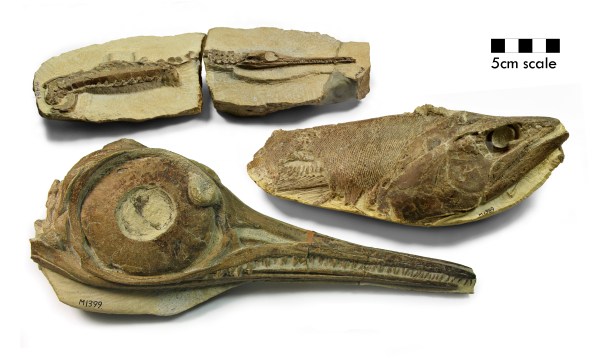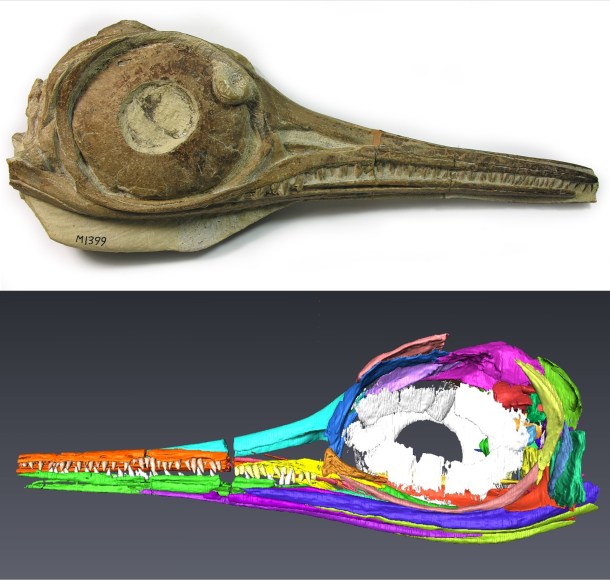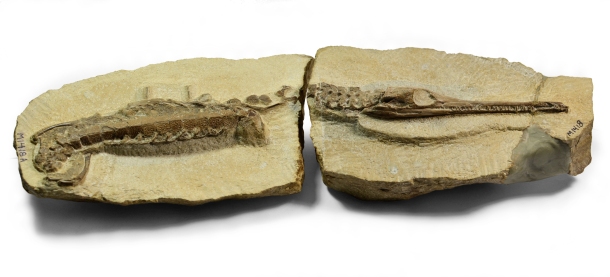The Journal of the Geological Society’s series of ‘Review Focus’ articles on fossil Lagerstätten continues with a remarkable fossil collection from Strawberry Bank, Ilminster, Somerset…

infant Pelagosurus crocodile (top), a Pachycormus fish (middle), and the skull of an ichthyosaur (Hauffiopteryx typicus , bottom) Credit: Bath Royal Literary and Scientific Institution.
In the early 1840s, noted Bath-based geologist Charles Moore (1815-1881) was out for a walk in Ilminster, Somerset, when he saw some school boys kicking a rounded boulder about. On cracking it open, to his amazement, Moore found a perfect three-dimensionally preserved fish inside – just one of a collection of fossils revealing secrets about life 190 million years ago.
Since that first find, Moore collected hundreds more of the nodules, forming a collection which has lain, almost forgotten, in the museum of the Bath Royal Literary and Scientific Institution in Queen’s Square, Bath.
Now, thanks to the exception preservation conditions, and a collaboration between the BRLSI and palaeontologists from the University of Bristol, the fossils are revealed in a paper published this week in the Journal of the Geological Society.
‘It was obvious that these fossils were very special from the first time I saw them on joining the BRLSI’ says Matt Williams, curator of the collection.
‘Our stores are full of treasures, but these specimens are truly unique. We secured some funding to clean and curate them, and uncovered some unexpected treasures.’

larger juvenile crocodile skull of the same species and about as long as the whole infant specimen. Credit: Bath Royal Literary and Scientific Institution
The collection includes two species of ichthyosaurs, tiny marine crocodiles and hundreds of insects.
‘When Matt first showed me the fossils I couldn’t believe it’ says Professor Michael Benton from the School of Earth Sciences, University of Bristol, who is collaborating on the project.
‘There are 100 nodules containing a large fish called Pachycormus, five or six tiny marine crocodiles, and two species of ichthyosaurs. There are also early squid with their ink sacs and other soft tissues preserved, and hundreds of insects that had flown out over the shallow, warm seas of the day’.

The skull of a juvenile ichthyosaur, Hauffiopteryx typicus and a model made from data gathered through X-Ray micro CT. Credit: to Bath Royal Literary and Scientific Institution
The site, Strawberry Bank, has now been built over and lost, but work has begun in earnest on preserving and studying the fossils Moore first discovered 150 years ago. A grant of £250,000 from the Leverhulme Trust will fund three-dimensional scanning and further research, with fossil fish expert Matt Freidman of the University of Oxford.
Journal reference:
- Williams, M., Benton, M.J. & Ross, A. 2015. The Strawberry Bank Lagerstätte reveals insights into Early Jurassic life. Journal of the Geological Society, first published online July 15, 2015, http://doi.org/10.1144/jgs2014-144

Is these photos from any museum?
Pingback: Strawberry Bank | Tim Holt-Wilson